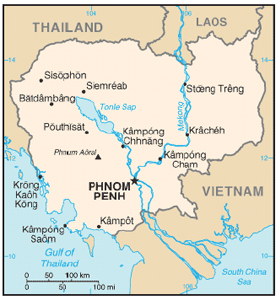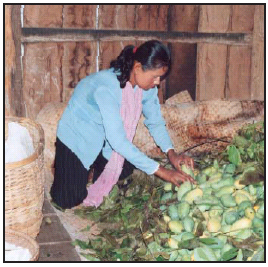| Country Profile: Cambodia
 |
President George W. Bush’s
Emergency Plan for AIDS
Relief is the largest commitment
ever by any nation for an
international health
initiative dedicated to
a single disease—a
five-year, $15 billion,
multifaceted approach to
combating the disease around the world.
U.S. Department of
State
U.S. Agency for
International
Development
U.S. Department of
Defense
U.S. Department of
Commerce
U.S. Department of
Labor
U.S. Department of
Health and Human
Services
Peace Corps
Mailing address:
SA-29, 2nd Floor
2201 C Street, NW
Washington, DC 20522-2920
www.PEPFAR.gov
| |
Country Profile: Cambodia
| HIV/AIDS in Cambodia
Adults and children (0-49) living with HIV at the end of 2005: 130,0001
AIDS deaths (adults and children) in 2005: 16,0001
AIDS Orphans at the end of 2005: Unknown1
HIV prevalence in Cambodia is among the highest in Asia. Although Cambodia is one of the poorest countries in the world, extraordinary HIV prevention and control efforts exerted by the Royal Government of Cambodia and its partners have helped to reduce the |
|
 |
| spread of HIV.2 Between 2003 and 2005, the estimated HIV prevalence among Cambodian adults ages 15 to 49 declined from 2.0 percent to 1.6 percent.1
Cambodia’s HIV/AIDS epidemic is spread primarily through heterosexual transmission and revolves largely around the sex trade. HIV transmission occurs mainly in sexual partnerships where one partner has engaged in high-risk behaviors.3 Women constitute a growing share of people living with HIV/AIDS, comprising an estimated 47 percent of people living with HIV/AIDS in 2003, compared with 37 percent in 1998.1 This increased proportion of infections among women may reflect declining prevalence rates among males, as well as deaths among males infected in the early years of Cambodia’s epidemic. Significantly, a low prevalence rate in the general population masks far higher prevalence rates in certain sub-populations, such as injecting drug users, sex workers, men who have sex with men, karaoke hostesses and beer girls, and mobile and migrant populations.
Partnership to Fight HIV/AIDS
The Royal Government of Cambodia has committed significant resources to fighting HIV/AIDS. Through the U.S. President’s Emergency Plan for AIDS Relief (Emergency Plan/PEPFAR), the U.S. Government (USG) and its partners are working in partnership with the Royal Government of Cambodia to implement Cambodia’s National Strategic Plan for HIV. Close cooperation between partner governments; non-governmental, community-based and faith-based organizations; and people living with HIV/AIDS are essential in building effective and sustainable HIV prevention, treatment and care services. Given the limited health care resources and capacity in many communities, the Emergency Plan is committed to building integrated HIV/AIDS prevention, treatment and care services that maximize the effectiveness of available services.
Recognizing the global HIV/AIDS pandemic as one of the greatest health challenges of our time, President George W. Bush announced the Emergency Plan in 2003 — the largest international health initiative in history by one nation to address a single disease. Under the leadership of the U.S. Global AIDS Coordinator, USG agencies implement the Emergency Plan, working collaboratively through interagency country teams under the direction of the U.S. Ambassador. These teams capitalize on the expertise of each USG agency and leverage partnerships with the host government, multilateral institutions, non-governmental organizations and the private sector to implement effective programs for combating HIV/AIDS and to ensure efficient use of USG resources.
Under PEPFAR, Cambodia received more than $16.8 million in Fiscal Year (FY) 2004 and approximately $17.4 million in FY2005 to support an integrated HIV/AIDS prevention, treatment and care program. In FY2006, the United States is providing approximately $19.3 million to support Cambodia’s efforts to combat HIV/AIDS.
1 UNAIDS, Report on the Global AIDS Epidemic, 2006.
2 Vonthanak Saphonn, MD, PhD, et al. “Trends of HIV-1 Seroincidence Among HIV-1 Sentinel Surveillance Groups in Cambodia, 1999-2002.” Journal of Acquired Immune Deficiency Syndromes. 39(5), August 15, 2005: pp. 587-592.
3 Elizabeth Pisani, et al. “Back to Basics in HIV Prevention: Focus on Exposure,” British Medical Journal. 326(21), June 2003: pp. 1384 -1387. | |
 |
Emergency Plan Achievements in Cambodia to Date |
|
Challenges to Emergency Plan Implementation
Cambodia is a post-conflict country, making scaling up activities a significant challenge. Major constraints to the implementation of HIV/AIDS activities include:
- High levels of high-risk sexual and substance use behaviors;
- Poverty, which drives prostitution, survival sex, and corruption;
- Barriers limiting access to prevention, care and treatment services, including distance to service locations, limited financial resources, a lack of transportation and infrastructure, and geographic barriers;
- Low salaries in the public health care sector; and
- Limited skills and capacity of health care providers.
|
| Reducing Stigma and Discrimination against People Living with HIV/AIDS
With support from the Emergency Plan, Pact Cambodia, an indigenous non-governmental organization, and the Cambodia People Living with HIV/AIDS Network are implementing the Community Response to Reducing HIV/AIDS Stigma and Discrimination Project. The project uses community fora to educate community members about HIV/AIDS. Lorn Khoeun, an HIV-positive 35-year-old from Tanuk village, witnessed the positive impact of the PEPFAR-supported community forum in her village. After losing her husband to an HIV/AIDS-related illness three years ago, Lorn Khoeun and her daughter faced stigma and discrimination from members of the community as a result of Lorn Khoeun’s HIV-positive status. Neighbors were afraid to buy watermelons or food from Lorn Khoeun, and her food selling business suffered as a result. Lorn Khoeun and fellow community members attended the community forum in her village where they discussed HIV/AIDS awareness; stigma and discrimination; HIV/AIDS law; and raising and mobilizing support for people living with HIV/AIDS from communities, local authorities, health care providers and opinion leaders. Since the forum, community members have altered their behavior and are more supportive of people living with HIV/AIDS. They are also friendlier towards Lorn Khoeun, buying her food and products, visiting her house, playing with her children, and eating together with her. Now, she can continue her business and support her daughter.
|
|

Lorn Khoeun’s food selling business is supported
by community members. |

Phally lives positively and teaches others to do
the same. |
|
Phally: The Story of a Courageous Woman
When the home-based care team first visited Phally in December 1999, she was depressed and sick with an HIV-related illness. At that time, there were minimal HIV/AIDS services available in her area, and a referral system linking patients to other available services was non-existent. Support from the Emergency Plan helped to establish a continuum of care for people living with HIV/AIDS in Phally’s home district. Phally never gave up her desire to make a positive difference in the lives of people living with HIV/AIDS. The involvement of Phally and other people living with HIV/AIDS in the continuum of care is central to the process of integrating and improving the quality of HIV/AIDS care, treatment and support services. Phally is now a skilled and active peer-educator and counselor, who serves as a positive role model for her peers. Her friendly, lively personality inspires all who meet her. “I’m a member of the care and treatment team at Moung Russey Referral Hospital,” Phally said. “I facilitate the ‘Friends Help Friends’ monthly support group meetings at the hospital. I also conduct counseling sessions with people living with HIV/AIDS, to prepare them for beginning antiretrovirals. An important part of my job is to visit people living with HIV/AIDS and their families while they are hospitalized, to provide moral support and information about HIV/AIDS and self care.”
|
| Buddhist Monks Provide HIV/AIDS Care
With support from the Emergency Plan, Buddhism for Development is helping to bridge the gap between the religious and secular communities in Cambodia. Buddhism for Development provides home-based care to people living with HIV/AIDS and services to children who have lost parents to HIV/AIDS. The group operates a six-week “Peace Development School,” at which monks learn to provide HIV/AIDS-related health care and study vocational training and agricultural extension methods. Of the monks who have gone through the Peace Development School, many returned to their home villages and established HIV/AIDS associations that provide HIV-prevention services and home-based care. These monks also established centers at pagodas, providing direct care and support for orphans and vulnerable children, and working to find ways to keep these children in school.
| |
| |  |  |



